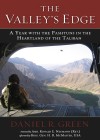The Valley’s Edge: A Year with the Pashtuns in the Heartland of the Taliban
Written by: Daniel R. Green,
Potomac Books, 2012,
ISBN 9781597976947, 288pp
Reviewed by: Timothy Moore
Modern Western militaries arguably need political capability — not to ensure internal ideological purity, but to identify, analyse and engage the politics of an operational area and secure peace. A successful war degrades foreign government, and the burden of stabilisation and restoration often falls on occupying forces. Possessing a political capability allows that force to move towards a sustainable peace. The Valley’s Edge by Daniel R. Green is a book about America’s political operations in Afghanistan which argues for a political capability in the modern Western military force.
The Valley’s Edge spans the decade that began with the attacks of 11 September 2001 and Green recounts his experiences as a newly appointed Pentagon public servant during the attacks. The narrative then moves quickly to America’s operations in Afghanistan. The book draws from Green’s journal and official reporting to vividly portray his time as a civilian political advisor with a Provincial Reconstruction Team (PRT) in Uruzgan province from 2005 to 2006. The final section describes Green’s return to Afghanistan as an officer in the US Marines from 2009 to 2011.
Green’s story focuses on the decisions and activities of his PRT and their place within the wider US effort. He offers war stories of missions and projects, provides character sketches and also explains the historical context of the operation. The stories capture the essence of front-line decision-making, constrained by both intelligence and time. Green intersperses the stories with his thoughts and comments on the events, US policies and characters of Afghanistan. His observations are a mix of contemporary reactions and retrospective commentary.
The power of The Valley’s Edge lies in its structure as a memoir. It is easy to read and draws the reader along effortlessly. Green delights in describing the landscapes and people he encountered. He does not lecture on counterinsurgency theories. Instead he portrays the way diplomats, aid bureaucrats, political advisers and military forces worked together — and failed to work together — in Afghanistan.
Green’s writing is a mix of strident patriotism, informed criticism and sympathy for Afghans. He introduces himself as a former Bush presidential campaign worker convinced of the justice of the Afghanistan war. At every stage he hopes for US success. However he is not blind to the US failures he has lived through and displays genuine sympathy for the Afghans. Despite this, Green remains committed to his patriotic convictions throughout. He is neither a myopic warmonger nor an anti-war activist. His interest lies in the achievements of the US and its allies in Afghanistan, successful or otherwise, and how these could have been improved.
The main lesson that Green draws from his experience is the need to understand and engage with local politics to win lasting peace. He makes a compelling case for political capability to be integrated into military operations. This capability must understand and engage often complex and intransigent local and regional polities during the operation. Green then argues that achieving this capability requires the combination of public and military services. His work as both a public servant and military officer lends authority to this point.
Green recognises the contributions and limitations of both public and military services. The laundry lists of USAID-funded projects which give no consideration to indigenous capability or sustainability are duly criticised. The US infantry and Special Forces are praised for their work creating a ‘security bubble’ for his PRT. At the same time he notes the military’s inclination to do what it does best: kill the enemy and destroy their networks. For that reason he does not believe that the military, acting alone, can secure peace in Afghanistan.
The Valley’s Edge provides readers with food for thought from the perspective of a man with unique experiences. It shows political capability at work in a complex war. The narrative of the memoir acknowledges the complexity of the situation, avoids theorising and draws out important lessons. Australian Army commanders and planners would do well to read this book as it will assist them to understand how best to exploit and support the Australian Defence Organisation’s political capabilities on operations.

